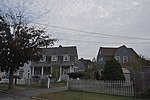Thompson Street School
Bristol County, Massachusetts Registered Historic Place stubsBuildings and structures in New Bedford, MassachusettsNational Register of Historic Places in New Bedford, MassachusettsSchool buildings on the National Register of Historic Places in Massachusetts

The Thompson Street School is a historic school building at 58 Crapo Street in New Bedford, Massachusetts. The 2+1⁄2-story school was built in 1884 to a design by Brownell & Murkland, and features a distinctive blend of Queen Anne, Stick, and Romanesque styling. It was built during a period of rapid growth in the area, and was named for James D. Thompson, a prominent locally-born military leader and politician. It was converted for use as a community center in 1976.The building was listed on the National Register of Historic Places in 1990.
Excerpt from the Wikipedia article Thompson Street School (License: CC BY-SA 3.0, Authors, Images).Thompson Street School
Thompson Street, New Bedford
Geographical coordinates (GPS) Address Nearby Places Show on map
Geographical coordinates (GPS)
| Latitude | Longitude |
|---|---|
| N 41.621388888889 ° | E -70.926944444444 ° |
Address
Thompson Street 52
02744 New Bedford
Massachusetts, United States
Open on Google Maps









